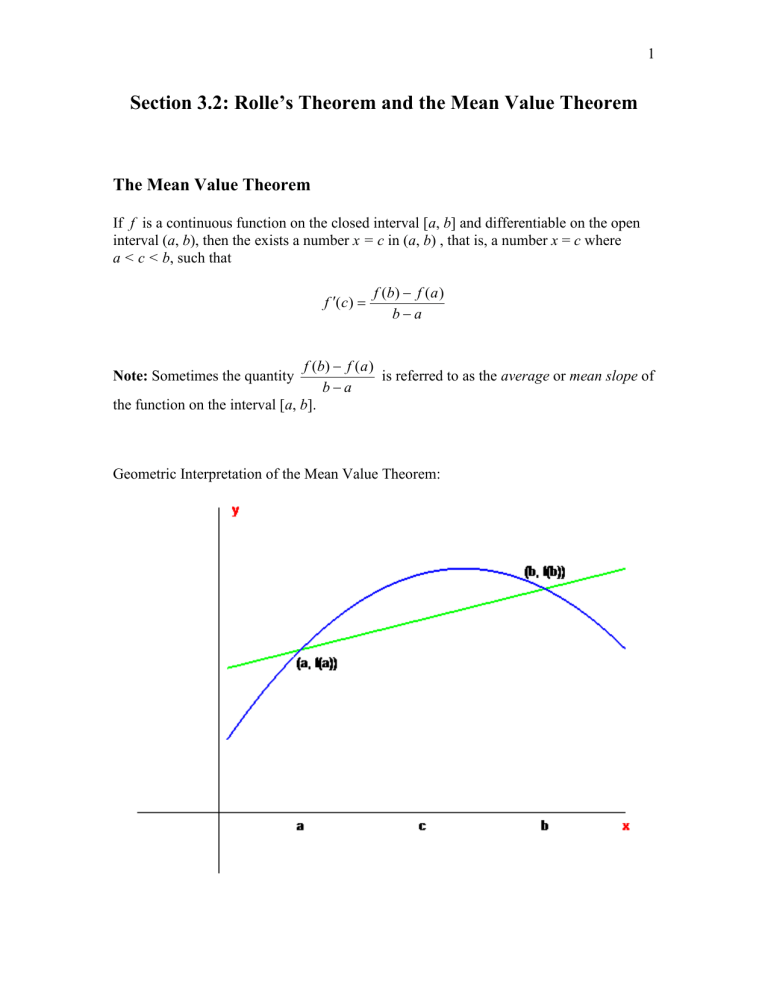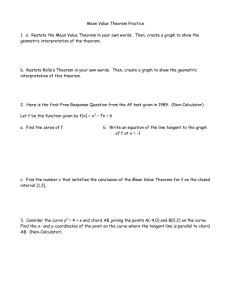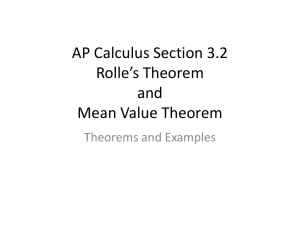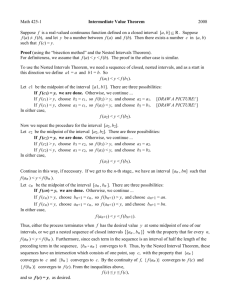Section 3.2

1
Section 3.2: Rolle’s Theorem and the Mean Value Theorem
The Mean Value Theorem
If f is a continuous function on the closed interval [ a , b ] and differentiable on the open interval ( a , b ), then the exists a number x = c in ( a , b ) , that is, a number x = c where a < c < b , such that f
( c )
f ( b b
)
a f ( a )
Note: Sometimes the quantity f ( b )
f ( a ) b
a
is referred to as the average or mean slope of the function on the interval [ a , b ].
Geometric Interpretation of the Mean Value Theorem:
2
Example 1: Use the graph of the following function to estimate a value of c that satisfies the conclusion of the Mean Value Theorem for the interval [0, 4].
Solution:
█
3
Example 2: Determine whether the Mean Value Theorem can be applied to the function f ( x )
2 x
3
5 x on the closed interval [ a, b ] = [-2, 2]. If so, find a value of c in the open interval ( a, b ) = (-2, 2) where f
( c )
f ( b ) b
a f ( a )
.
4
Example 3: Determine whether the Mean Value Theorem can be applied to the function
2 f ( x )
3 x 3 interval ( a, b
2 x on the closed interval [ a, b ] = [0, 1]. If so, find a value of c in the open
) = (0, 1) where f
( c )
f ( b ) b
a f ( a )
.
.
Solution: To see whether the function
2 f ( x )
3 x 3
2 x satisfies the criteria for the Mean
Value Theorem, first note that f ( x )
2
3 x
3
2 x is defined for all values of x in the closed interval [0, 1]. Thus,
2 f ( x )
3 x 3
2 x must be continuous for all values of x in the interval [0, 1]. To test the next criteria, we compute the derivative of the function f , which is given by f
( x )
3 (
2
3
) x
1
3
2
2
1
1 x 3
2
2
3 x
2 ,
For the close interval ( a, b ) = (0, 1), f
( x )
3
2 x
2 is defined for all values in (0, 1)
(note, that the endpoint x = 0 is not included in this interval). Thus, f
( x )
3
2 x
2 must be continuous for all values of x in the interval (0, 1). Since the criteria of the Mean
Value Theorem are satisfied, we look for a value of c where f
( c )
f ( b )
b
a f ( a )
For this example, a = 0 and b = 1. Thus, for the function f ( x )
2
3 x 3
2 x , f f ( a )
( b )
f f
(
( 0 )
1 )
3 ( 0 )
2 / 3
3 ( 1 )
2 / 3
2
2 ( 0 )
( 1 )
0
3
0
2
1
0
.
And for the derivative f
( x )
3
2 x
Formula, we obtain the following:
2 , f
( c )
2
3 c
2 . Thus, using the Mean Value
(Continued on next page)
2
3 c
2
f
( c )
f ( b b
)
a f ( a )
f ( 1 )
1
0 f ( 0 )
3
2 c
2
1
1
0
(Use fact from above that f ( 0 )
0 and f ( 1 )
1
3
2 c
2
1 (Simplify)
3
2 c
3 (Add 2 to both sides)
3
2 c
3 c
3
3 c (Multiply both sides by
3 c
3
3 c
2 (Rearrange and simplify)
3 c
`
2
3
(Divide both sides by 3)
(
3 c )
3
`(
2
3
)
3
(Raise both sides to third power to eliminate radical) c
8
27
(Simplify and solve for c )
Thus, the value of x
c
8
satisfies the Mean Value Theorem. This value is further
27 illustrated with the following graph:
(Continued on next page)
5
6











